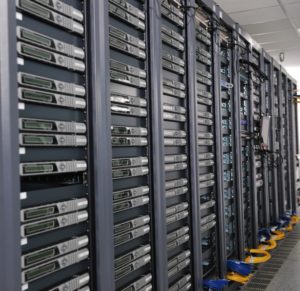Blade servers and rack servers are the stock-in-trade of data centers, chosen for their versatility, security, and ability to configure and connect large amounts of computing power in small spaces. But while blade servers and rack servers accomplish the same goal of organizing your server base, they do it in very different ways. Which one of them you choose could have big impacts on your budget, your data architecture, your power supply, and the design of your cabling and cooling systems.
How do you know which one is right for your company? Let’s break down the things you need to know.
What is a Rack Server?

A rack server is one of the most useful items in IT hardware, allowing you to keep multiple servers in a safe, space-saving rack structure. Server boards are stored in mounting slots called bays and can often hold between one and eight server units. Unlike tower racks that are designed to be stored in their own cabinets, a server rack has a lower profile that sits on a shelf, keeping your servers off the floor.
See Blade Servers vs Rack Servers vs Tower Servers
Rack servers are practical for their versatility, which allows them to be stacked, extended, and perhaps most importantly, networked.
Advantages and Disadvantages of Rack Servers
Pros:
- Capability: A rack server is able to run truly intensive computing operations. Why? Because each rack server operates as its own self-contained unit, possessing its own power source, CPU and memory. Network them together, and they are more powerful, still.
- Space-saving efficiency: Rack servers pack a high amount of computer power into a very versatile, small space. They can be mounted on shelves or stacked in cabinets.
- Scalability: Because rack servers are so flexible, they can be easily expanded to add additional memory, storage, and processors. They can easily be hot swapped for clustering, networking, or creating redundancies.
- Cost effective: Not only are rack servers generally cheaper than other server types, they can also be a good choice for smaller deployments, as they are more flexible to store and operate.
Cons:
Heat and cabling tend to be the main ones. Rack servers typically run a little hotter than other options, and require more cabling too. This means you’ll be working harder to maintain your cabling and spending more on your cooling systems than if you’d chosen a different rack configuration.
See our picks for Top Rack Servers of 2021
What is a Blade Server?

A blade server is a type of architecture that has a single chassis but houses multiple server modules, known as “blades.” The chassis provides the power supply to the blades, but because of the way they are constructed and enclosed, blade servers can run well independently of each other, or in concert with each other.
Each blade is self-contained in its own enclosure, each having its own CPU, RAM and storage. Blade servers can house more components in a smaller space than other types of server architectures. Because each blade can slide easily in and out of the chassis, the blades themselves are easier to expand and easier to maintain than other types of options. Each blade server can run independently with its own management system, which usually includes a network or storage switch.
Advantages and Disadvantages of Blade Servers
Pros:
- Cheaper to cool and run: While blade servers emit their fair share of heat, especially when large numbers of them are grouped together, the heat they give off is still lower than the heat index for rack servers. Blade servers also don’t require so much cabling, which lowers costs and complications.
- Processing power: Blade servers can give you more bang for your buck, packing more processing power into a smaller space.
- Enterprise flexibility: Using this server configuration, you can host hypervisors, databases, applications, web services and data system storage, or any single task system, making it a good choice for systems that can run in a self-contained way.
- Central monitoring: A blade server can be monitored from a networked, single source, which makes it far easier to handle load balancing, maintenance, and clustered failover.
Cons:
- Startup costs: While the costs tend to amortize well over time, initial investments in blade servers can be considerably higher than a rack server setup. However, reduced maintenance and energy costs often mitigate this.
- Heat density: We’ve already said blade servers run cooler than rack servers. And that’s true. But they are also very densely configured. When many blade servers are packed close together, which is generally the case, the heat that’s generated will create ventilation concerns. Be sure to consult with installation experts who can help you create a well cooled, well ventilated data center that can handle your current installation, as well as any upgrades or additions you may make in the future.
Making the decision on your server architecture is one of the most important decisions you can make. Which you choose will likely be dictated by your space and processing needs.
See our picks for Best Blade Servers of 2021

